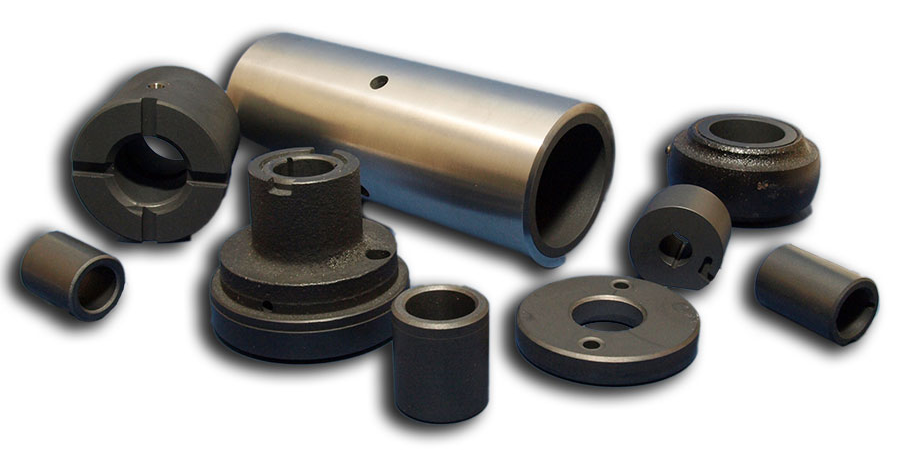An article in WaterWorld shared some interesting facts about pump bearing failures. They highlight that 2/3 of rolling element bearings require replacing before their expected fatigue life. The article further explains:
- 1/3 fail because of lubrication problems
- 1/6 fail because of contaminants
- 1/6 fail because of incorrect fitting, selection, or damage from external causes
Lubrication Problems
Problems with lubrication are the major cause of premature bearing wear and failure, but it’s not just an issue of insufficient lubrication.
- Over or under filling can also cause problems, as can using an incorrect or incompatible lubricant or mixing products inappropriately.
- Your lubrication process and timing can also be the culprit. Preventing contamination in your lubricant will also help reduce potential problems.
Options for self-lubricating, carbon graphite bearings existing and can greatly reduce or even eliminate some of the common lubrication issues.
| In most instances where lubrication problems exist, there is either a lack of lubricant, a restriction to the flow of the lubricant, or a breakdown of the lubricant itself.
As a result, damage occurs to the bearing due to contact between two metal surfaces. Temperatures increase and discoloring or darkening occur. Hot spots can also result in scoring, peeling or even distortion of the bearing itself. Eventually, a bearing can lock up or seize completely. Bearings will come with manufacturer’s recommendations on the amount, type, and grade of lubricant. The manufacturer should also supply you with guidelines on how and when to supply the lubricant. Factors like viscosity and the use of additives will vary based on your intended use including loads, speeds, seals, and environmental conditions. Distributors may also be a source of best practices and advice when navigating instructions from the manufacturer. Keep in mind that lubricants have a shelf life and storage recommendations that can influence their effectiveness. Problems with lubrication are the major cause of premature bearing wear and failure, but it’s not just an issue of insufficient lubrication. Over or under filling can also cause problems, as can using an incorrect or incompatible lubricant or mixing products inappropriately. Your lubrication process and timing can also be the culprit. |
What to look for in a bearing...Bearing selection is important. Consider some of these features when making your decision:
|
Carbon graphite bearings also have limited dry running survivability in the event a valve is in an inappropriate position and the process fluid flow is interrupted.
Contamination
It doesn’t take much to contaminate the oil film on a bearing and damage the surface. Dust or dirt, debris of any kind, or water can all be detrimental.
As little as 1% water in grease or oil can significantly shorting bearing life. Machine Design.
Carbon graphite materials are an excellent bearing choice when corrosion precludes the use of other materials.
For instance, the addition of 10% ethanol to gasoline cause premature failure in fuel pump bearing which carbon graphite bearings quickly solved
Contamination from sand or fine metals from machining are common sources as are general dust or debris in the atmosphere.
A contaminant acts as an abrasive, causing visible denting and bruising on the raceways and can even embed or wedge itself on the bearing surface. Contaminants can have an abrasive effect on seals, housings and other elements, or contaminate your lubricant.
Moisture is also a significant contaminant which can cause corrosion or etching in the bearings.
Prevent Contamination with Custom Seals
Preventing contamination relies heavily on the proper selection and use of seals. Like making a choice on a lubricant, you should always select a seal specific to your conditions and use based on manufacturer’s recommendations.
If you can’t locate a seal that will work for your project, don’t settle for “close enough.”
You can have seals custom designed and manufactured.
Our experience is that when a seal grade and design is specific to your needs, you will see better results, and fewer issues down the road. Beyond just choosing the best seal for the job, it’s important to handle and install the seal correctly ensuring that there is no contamination or damage.
 Proper maintenance of seals is just as important.
Proper maintenance of seals is just as important.
- A routine check for cracking, leaks, or contamination buildup is good preventative maintenance practices.
- Clean seals according to the manufacturer’s recommendations as steam or compressed air are not suitable for all seals and can cause damage.
- External shields are also a good way to help prevent the build-up of debris around seals.
Good work practices can go a long way in preventing contamination. Clean tools, work surfaces, and hands are important to removing contamination sources.
It’s also a good idea to keep activities that generate potential contaminants away from any bearing assemblies, lubricants, or where you store your seals, and always store seals in their original packaging until they’re ready for use.
Bearing Selection, Handling, Installation
You can prevent 1/6th of bearing failures by selecting and installing it correctly.
When choosing the best bearing for the job, consider the load, speed, environment, and expected life for the application. Also consider that bearings are composed of a variety of materials, from carbon graphite, to chrome and stainless steel, or ceramic and some will be better suited to specific applications.
Other factors like the internal clearance, seal requirements, and the quality of the brand you’re considering are also important.
 Once you’ve selected the right bearing, proper installation, with the proper tools is equally important.
Once you’ve selected the right bearing, proper installation, with the proper tools is equally important.
- Good work practices, including a clean environment will be important. Store the bearing correctly prior to use, avoid removing any of the preservative on the bearing, and wear gloves if possible when handling to prevent contamination or corrosion.
- A small nick during installation can lead to quick deterioration and downtime.
- Alignment, internal clearance, and other bearing settings are important to proper installation. Even a small misalignment can cause premature fatigue in the housing or the bearing itself. A loose fit for example results in an imperfect alignment or mating of parts leading to fretting. A tight fit on the other hand creates an excessive load, rapid temperature increases, and quick signs of wear and fatigue.
How We Prevent Bearing Failure
To prevent bearing premature wear or failure, our practice is to review the applications, materials of construction, constraints, and goals so that we can propose the most appropriate custom carbon graphite grade.
Another consideration is the interference fit which is a function of the carbon graphite grade, mating metals, and operating temperature. We can provide guidance on these factor and press fit the carbon in housings where desired.
In addition to the selected grade, the bearing design can be of equal importance with which we can also assist.
The use of carbon graphite bearing can in some circumstances eliminate the cost, mess, and maintenance of a greased metal bearing.



